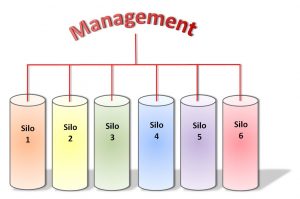 Recently I shared a Facebook post in which Shira Goodman, CEO of Staples recalls her best career advice:
Recently I shared a Facebook post in which Shira Goodman, CEO of Staples recalls her best career advice:
“Be open to making lateral moves.”
I agree – making lateral moves is what propelled my career too. However, we often think that we should stay within our functional area so we can build the relationships we need to work our way up the corporate ladder. But that theory is so mid-20th century!
To get ahead in the 21st century we need to think about how a 21st century company really functions.
First, take a look at your company’s organizational chart(s). You will probably see lots of functional silos. This reflects 19th century management theory when manufacturing drove our economy.
The male-dominated workplace however still loves these functional silos because they allow men to use an expertise to acquire status. That expertise can be in a skill/profession, client type, region or project/production phase. As men work within their silo gaining knowledge and experience they master their functional area and become our awe-inspiring experts.
Take a moment to think about how you think about experts.
We expect experts to know the best way to do something. We don’t question the experts. We expect that a workplace that has lots of experts in their functional silos to perform the best. But do they really?
Let’s do a 21st century reality check.
In the course of doing your work, how often do you interact with people from different functional silos? Probably quite a bit.
And how often do you or your co-workers have problems getting the right or complete information from people in the other functional silos so you can do your job quickly and efficiently?
Probably a lot. If you think about it, you will probably realize you waste a good part of your day trying to correct work passed to you from other people.
The problem is that the old functional silo structure assumes that the experts can best complete their work without the interaction (distraction) of others. Sometimes that work is then “handed-off” to another functional silo to complete by itself. However, the handed-off work is often completed in a manner that suits the first silo but not the second. This causes rework for the second.
While this system works well for silo managers and the experts, it doesn’t work well for the workforce who interact all day long with people from multiple silos.
21st century workplaces are more complex and therefore require integrating work across the silos so the big picture work gets done efficiently. Silo managers can no longer just look down through their silo – they must look across all silos and integrate the work of their silo with that of the others. They must bring all the functional areas and people together to function as one entity. This is the primary responsibility of 21st century management.
The old mentality of working your way up your silo doesn’t prepare managers to integrate work. However, someone who has moved from silo to silo understands how work has to get done from the perspective of more silos. They understand the integration necessary for the company to perform better. They will be better managers.
The male-dominated workplace and academia however, still don’t appreciate the power of integration because it reduces the status of their expertise. They consider people who move from functional area to functional area as a “jack of all trades but master of none.”
But integration of activities and functions is an expertise. It is an expertise that requires communication, coordination, collaboration and multiple task management skills. These are skills women excel at far better than men. This is why women need to aspire to middle and senior management positions in the 21st century.
So, if you are one of those people who has moved between functional areas a lot and believe your career options are limited because you don’t have one big area of expertise, change your perspective. You just may be an integration and efficiency expert. Go for that management position! because you have skills that do not. You will outperform your siloed male colleagues.
Empowered Women Manage Through Integration


Trackbacks/Pingbacks